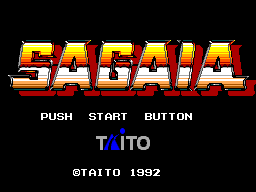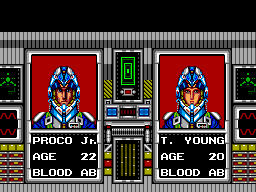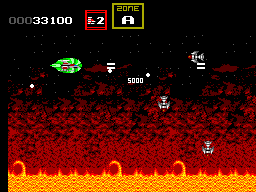|
 |
|
|
|
|
Review Information |
|
|
 |
|
|
Reviewer Name: |
Transatlantic Foe |
|
|
|
|
|
|
Game Difficulty: |
Easy |
|
|
Difficulty Options: |
True |
|
 |
|
|
|
 |
|
|
|
|
Game Information |
|
|
 |
|
|
Full Title: |
Sagaia |
|
|
Year Released: |
1992 |
|
|
Game Type: |
Shooting |
|
|
Max Players: |
1 |
|
 |
|
|
|
| Introduction |
|
|
| Sagaia is actually the second installment of the Darius series, possibly because of Darius' lack of impact in Europe Taito marketed this game as Sagaia - it appeared in arcades with a three screen wrap-around system which was mighty fancy for the time but ultimately it proved a gimmick, since Darius 2 is a pretty standard side-scrolling shmup. Like the original Darius, you face off against an array of robotic aquatic forms to restore freedom to our solar system, like you do. |
| Gameplay |
| What you've got in Sagaia is a pretty straightforward side-scrolling shmup, it's got the usual power-ups of main cannons, bombs and shields - plus a laser weapon that's next to useless until you get it to level two. Like the original Darius, you have multiple paths you can take as the game progresses - each leads to a different final boss battle and a unique ending, with some paths being much more challenging than others.
Since we're on 8-bit here, the power of arcade platforms in the late 80s shines through because of the original 28 levels less than half remain for this home version. It's not massively unexpected but it does reduce the replay value of the game somewhat. Additionally, and again not entirely unexpectedly, the two player mode from the arcade game is scrapped - instead you can choose your pilot. In the arcade both are identical, but here selecting Tiat Young gives a slightly easier game - you start with more power to all of your weapons.
Once more, there is no way the home console can replicate the three screen view of the arcade game so the game cuts things down a little - but it's not really noticeable and still plays rather well. Except that it's rather unbalanced. When you die, you lose all your power-ups - not exactly a new concept but unfortunately in Sagaia the difficulty skyrockets as the game goes on. The end result? If you die in the last couple of stages you may as well give up. The flipside? If you're fully powered up you'll toast your way through the tougher stages even if you're hardly paying attention. It's a shame but it's the sort of thing which separates a decent side-scroller from a great one. |
| Graphics |
| Wow. Seriously, wow. The limited colour palette and black background for boss fights are the only giveaways that you're playing an 8-bit game. This game looks seriously great and is incredibly close to the arcade original - albeit with smaller sprites due to the condensing of three screens into one. The bosses are particularly incredible - in many cases they match or surpass the Mega Drive version. Despite it being a complete pussy, first boss Hyper Sting looks even better than the Saturn arcade perfect version. Now there's a turnup for the books!
But there's a downside. And tragically it's a massive, massive downside. This game suffers really badly from not only hideous slowdown but some of the worst flicker ever encountered in a video game. Plenty of the boss battles are monumentally easy thanks to slowdown - particularly Alloy Lantern, Drio Sawn, Leadain and Grand Octopus - which is a real shame because they look identical to the arcade version.
The massive drawbacks in flicker and slowdown can be overcome with repeated play - you get used to where it happens and when to move about to reduce the risk of being taken out by bullets you can't see. But it certainly isn't ideal and you can't help but feel that, given the quality of the likes of Power Strike II, that if Sega would've waited almost as long for this conversion as they did with the Saturn version then they'd have landed a far superior product. |
| Sound & Music |
| The laser and explosion effects are pretty standard shmup fare, so they're nothing special but not exactly annoying either. However the music is a triumph. To get the SMS to produce decent music is a mighty challenge in itself and although 1988's Power Strike set the bar seriously high, Sagaia has a really good stab. The tunes, if played along with the better-than-arcade Saturn versions, are instantly recognised and seriously close to the original - it's mainly just a few fancy effects that are missing which is a massive achievement. |
| Controls |
| Button 1 shoots cannons and lasers while 2 drops your bombs. There's a limited strategy with bombs and lasers when it comes to taking out ground turrets and the directional bomb behaviour mirrors the arcade, so well done keeping the core gameplay together. Your ship is also seriously rapid which, while it can lead to a few accidental bumps on the first few games, is soon overcome as you learn how not to overcompensate with movements.
Even with the graphical limitations, the controls remain responsive and faithful to - if not faster than - the arcade game. |
| Replay Value |
|
| The various paths and three different endings give more replay value than your average straight-up 6-7 stage shmup - extra difficulty settings give a further challenge. Although once you've learned a few stages and where the flicker gets bad, you'll want to stick it on hard because it is way too easy to finish the game on easy and normal - thanks partly to slowdown and partly to plentiful shields coupled with you rapidly reaching monumental firepower. Ultimately, once you get around the flicker it's a perfect game for a short blast now and again. |
| Conclusion |
| The fact that it took Sega and Taito until 1996 to come up with an arcade perfect version of Darius 2/Sagaia speaks volumes and also excuses some of the shortfalls of this 8-bit version - but while the graphics and sound are seriously close to the arcade it does fall over with flicker and slowdown when it moves - which is a seriously flaw that does somewhat restrict it to shmup and Darius fans only.
Given few Mega Drive side-scrollers feature two player modes it's not surprising that this feature from the arcade game is ditched for the Master System port, and one cannot help but feel likewise about the reduced number of levels. Commonly SMS shmups feature 5 or 6 levels so to expect the full 28 would be wishful thinking - so while the number is reduced, the spirit of branching paths remain.
Overall, shmup fans will want to grab this because they can get around the flaws in the game - the loss of all weapons on death is common to the genre, while the slowdown and flicker will seriously put off the casual but the experienced shmup player will easily be able to work around it. Ultimately, this is a monumental achievement despite its flaws. If only it was left until programmers could fully exploit the machine's capabilities - as it stands it's essential for shmup fans but so-so for the casual player. |
|
|
|
|











